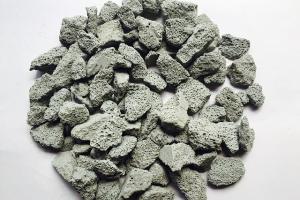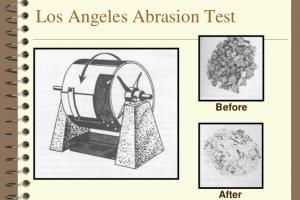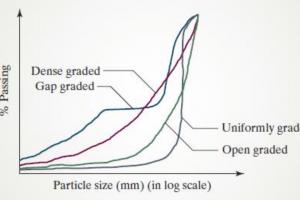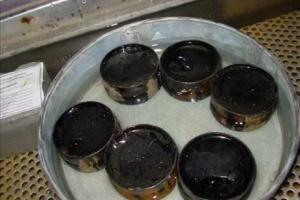Tests Applied on Bitumen in Roads for Quality Construction

Experience in using bitumen in engineering projects has led to the adoption of certain test procedures that are indicative of the characteristics that identify adequate performance levels. Some of the tests have evolved with the development of the industry and are empirical methods. Consequently it is essential that they are carried out in strict compliance with the recommended procedures if they are to be accurate measurements of the bitumen's properties.
Penetration Test on Bitumen
The penetration test is one of the oldest and most commonly used tests on asphalt cements or residues from distillation of asphalt cutbacks or emulsions. The standardized procedure for this test can be found in ASTM D5 [ASTM, 2001]. It is an empirical test that measures the consistency (hardness) of an asphalt at a specified test condition.
Procedure of Penetration Test on Bitumen:
In the standard test condition, a standard needle of a total load of 100 g is applied to the surface of an asphalt or Liquid bitumen sample at a temperature of 25 °C for 5 seconds. The amount of penetration of the needle at the end of 5 seconds is measured in units of 0.1 mm (or penetration unit). A softer asphalt will have a higher penetration, while a harder asphalt will have a lower penetration. Other test conditions that have been used include
- 0 °C, 200 g, 60 sec., and
- 46 °C, 50 g, 5 sec.
The penetration test can be used to designate grades of asphalt cement, and to measure changes in hardness due to age hardening or changes in temperature.
![]() Read a detailed procedure of Bitumen Penetration Test with Sample Data
Read a detailed procedure of Bitumen Penetration Test with Sample Data
Flash Point Test on asphalt:
The flash point test determines the temperature to which an asphalt can be safely heated in the presence of an open flame. The test is performed by heating an asphalt sample in an open cup at a specified rate and determining the temperature at which a small flame passing over the surface of the cup will cause the vapors from the asphalt sample temporarily to ignite or flash. The commonly used flash point test methods include
- The Cleveland Open Cup (ASTM D92)
- Tag Open Cup (ASTM D1310).
The Cleveland Open-Cup method is used on asphalt cements or asphalts with relatively higher flash points, while the Tag Open-Cup method is used on cutback asphalts or asphalts with flash points of less than 79 °C. Minimum flash point requirements are included in the specifications for asphalt cements for safety reasons. Flash point tests can also be used to detect contaminating materials such as gasoline or kerosine in an asphalt cement. Contamination of an asphalt cement by such materials can be indicated by a substantial drop in flash point.
When the flash point test is used to detect contaminating materials, the Pensky-Martens Closed Tester method (ASTM D93), which tends to give more indicative results, is normally used. In recent years, the flash point test results have been related to the hardening potential of asphalt. An asphalt with a high flash point is more likely to have a lower hardening potential in the field.
![]() Read a detailed procedure of Bitumen Penetration Test with Sample Data
Read a detailed procedure of Bitumen Penetration Test with Sample Data
Solubility Test on asphalt bitumen
Asphalt consists primarily of bitumens, which are high-molecular-weight hydrocarbons soluble in carbon disulfide. The bitumen content of a bituminous material is measured by means of its solubility in carbon disulfide.
Procedure for Solubility test on Bitumen
In the standard test for bitumen content (ASTM D4), a small sample of about 2 g of the asphalt is dissolved in 100 ml of carbon disulfide and the solution is filtered through a filtering mat in a filtering crucible. The material retained on the filter is then dried and weighed, and used to calculate the bitumen content as a percentage of the weight of the original asphalt. Due to the extreme flammability of carbon disulfide, solubility in trichloroethylene, rather than solubility in carbon disulfide, is usually used in asphalt cement specifications. The standard solubility test using trichloroethylene is designated as ASTM D 2042.
The solubility test is used to detect contamination in asphalt cement. Specifications for asphalt cements normally require a minimum solubility in trichloroethylene of 99.0 percent.
Unfortunately, trichloroethylene has been identified as a carcinogen and contributing to the depletion of the earth’s ozone layer. The use of trichloroethylene will most likely be banned in the near future. There is a need to use a less hazardous and non-chlorinated solvent for this purpose. Results of several investigations have indicated that the solvent n-Propyl Bromide appears to be a feasible alternative to trichloroethylene for use in this application.
![]() Read a detailed procedure of Bitumen Penetration Test with Sample Data
Read a detailed procedure of Bitumen Penetration Test with Sample Data
Ductility Test on Asphalt
The ductility test (ASTM D113) measures the distance a standard asphalt sample will stretch without breaking under a standard testing condition (5 cm/min at 25 °C). It is generally considered that an asphalt with a very low ductility will have poor adhesive properties and thus poor performance in service. Specifications for asphalt cements normally contain requirements for minimum ductility.
![]() Read a detailed procedure of Bitumen Ductility Test with Sample Data
Read a detailed procedure of Bitumen Ductility Test with Sample Data
Viscosity Tests on Bitumen Asphalt
The viscosity test measures the viscosity of an asphalt. Both the viscosity test and the penetration test measure the consistency of an asphalt at some specified temperatures and are used to designate grades of asphalts. The advantage of using the viscosity test as compared with the penetration test is that the viscosity test measures a fundamental physical property rather than an empirical value. Viscosity is defined as the ratio between the applied shear stress and induced shear rate of a fluid.
Shear Rate = Shear Stress / Viscosity
When shear rate is expressed in units of 1/sec. and shear stress in units of Pascal, viscosity will be in units of Pascal-seconds. One Pascal-second is equal to 10 Poises. The lower the viscosity of an asphalt, the faster the asphalt will flow under the same stress. For a Newtonian fluid, the relationship between shear stress and shear rate is linear, and thus the viscosity is constant at different shear rates or shear stress. However, for a non-Newtonian fluid, the relationship between shear stress and shear rate is not linear, and thus the apparent viscosity will change as the shear rate or shear stress changes.
Asphalts tend to behave as slightly non-Newtonian fluids, especially at lower temperatures. When different methods are used to measure the viscosity of an asphalt, the test results might be significantly different, since the different methods might be measuring the viscosity at different shear rates. It is thus very important to indicate the test method used when viscosity results are presented.
The most commonly used viscosity test on asphalt cements is the Absolute Viscosity Test by Vacuum Capillary Viscometer (ASTM D2171).
The standard test temperature is 60 °C. The absolute viscosity test measures the viscosity in units of Poise. The viscosity at 60 °C represents the viscosity of the asphalt at the maximum temperature a pavement is likely to experience in most parts of the U.S. When the viscosity of an asphalt at a higher temperature (such as 135 °C) is to be determined, the most commonly-used test is the Kinematic Viscosity Test (ASTM D2170), which measures the kinematic viscosity in units of Stokes or centi-Stokes. Kinematic viscosity is defined as: When viscosity is in units of Poise and density in units of g/cm3 the kinematic viscosity will be in units of Stokes. To convert from kinematic viscosity (in units of Stokes) to absolute viscosity (in units of Poises), one simply multiplies the number of Stokes by the density in units of g/cm3.
![]() Read a detailed procedure of Bitumen Penetration Test with Sample Data
Read a detailed procedure of Bitumen Penetration Test with Sample Data












